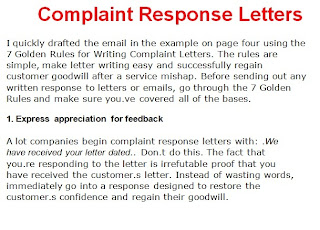7 tips of Writing Complaint Response Letters :
I quickly drafted the email in the example on page four using the7 Golden Rules for Writing Complaint Letters. The rules are
simple, make letter writing easy and successfully regain
customer goodwill after a service mishap. Before sending out any
written response to letters or emails, go through the 7 Golden
Rules and make sure you’ve covered all of the bases.
1. Express appreciation for feedback
A lot companies begin complaint response letters with: “We
have received your letter dated…” Don’t do this. The fact that
you’re responding to the letter is irrefutable proof that you
have received the customer’s letter. Instead of wasting words,
immediately go into a response designed to restore the
customer’s confidence and regain their goodwill.
My favorite approach to beginning a complaint letter is to
begin by expressing appreciation for the feedback. Here are
some ways to express appreciation for customer feedback:
! “Thank you for taking the time to write to us.”
! “Thank you for your letter. We appreciate customers
who let us know when things aren’t right.”
! “Thank you so much for taking the time to write to us.
We appreciate the opportunity to clarify what we think
has happened.” (This is ideal for a response letter to a
customer who is actually responsible for the error or
when you cannot honor the customer’s request for a
refund or exchange.)
2. Show empathy
If you’ve participated in one of our seminars, you’ve no doubt
heard me preach on the value of empathy. Empathy can be a
powerful tool used to disarm an angry customer and show that
www.myragolden.com 7
you genuinely care about the inconvenience the customer has
experienced. Not to be confused with sympathy, empathy is
Identification with and understanding of the customer’s
situation and feelings.
You can express empathy by saying something similar to, “It
must have been very frustrating for you have waited 5 days
for your order and for that I am sorry.”
3. Apologize
Make a note of this rule: Never send out a response letter
without an apology. Never.
Research has found that when an apology is perceived as
genuine, customer satisfaction increases 10% –15%. An
apology should be offered both when the company is
responsible for the problem and when the company is not
responsible. An apology does not have to be an admission of
fault. For example, you might say, “I’m so sorry for any
misunderstanding you have experienced.” Or “If I were in your
shoes, I’m sure I’d feel just as you do. I’m sorry for the
frustration you have experienced.”
4. Respond with a sense of urgency (This includes both
responding immediately and expressing a sense of urgency
about regaining goodwill.)
Ninety-five percent of complaining customers will remain your
customer if their problems are resolved immediately.
Immediately meaning that visit or that phone call. This is
compared to only 70% when there is a delay in resolution. To
maximize your opportunity to regain goodwill and keep the
customer, you’ll want to work with and demonstrate a sense
of urgency. Make it clear that resolving the problem is as
important to you as it is to the customer. You can demonstrate
a sense of urgency with your words, tone and literally by
moving quickly to resolve the problem.
In the example response email from page 4 of this eBooklet, I
demonstrated a sense of urgency at two points:
A. “We will immediately send you a new workbook with black
print. We will ship that today.”
B. “Ms. Boese, I’m eager to restore your confidence in our
company and regain your goodwill. As a concrete form of
apology, I am also sending you a disk with my PowerPoint
presentation.”
5. Tell the customer what you’re going to do
Clearly explain to the customer exactly what you plan to do to
resolve the problem. This is especially important if the
resolution will take some time.
6. Give them double for their trouble (Add a goodwill
token like a coupon or a complimentary product)
In my email to Ms. Boese, I did this with this statement: “I
am also sending you a disk with my PowerPoint presentation.”
Sometimes in complaint resolution, it is appropriate to add a
little something to the recovery to ensure customer goodwill.
This can be as simple as a coupon inviting the customer to
come back and try your product or service at a discount. It
won’t always be necessary to make it a double for their
trouble but doing this can help maintain and strengthen
loyalty.
7. Invite customer to contact you if they aren’t satisfied
Make it easy for your customers to contact you if they need
more information. Always give your name, toll-free number,
email address and website.
When you respond to complaint letters and emails using the 7
Golden Rules, your letters will be customized, sincere and
professional and they will not only deliver a resolution, but will
facilitate your restoring the customer’s confidence in the
company and maintaining customer loyalty.

No comments:
Post a Comment